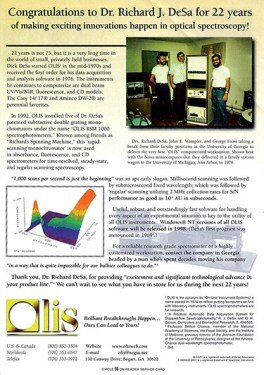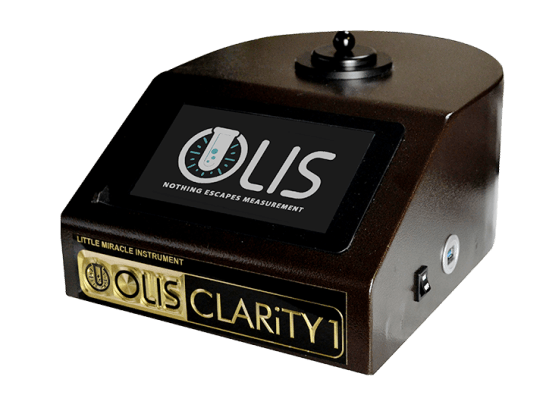Uv/vis/nir - Questions
Uv/vis/nir - Questions
Blog Article
The 10-Minute Rule for Spectrophotometers
Table of ContentsSome Ideas on Circularly Polarized Luminescence You Should KnowNot known Incorrect Statements About Uv/vis The Spectrophotometers PDFsThe 5-Second Trick For Uv/visEverything about Uv/vis/nirThe Single Strategy To Use For Uv/visThe 15-Second Trick For Circularly Polarized LuminescenceNot known Facts About Circular DichroismThe Main Principles Of Circular Dichroism Getting My Uv/vis/nir To Work7 Simple Techniques For Uv/visNot known Incorrect Statements About Uv/vis/nir Some Ideas on Circularly Polarized Luminescence You Should Know
It is then scanned through the sample and the referral solutions. Fractions of the occurrence wavelengths are sent through, or shown from, the sample and the recommendation. The resultant light strikes the photodetector gadget, which compares the relative intensity of the 2 beams. Electronic circuits convert the relative currents into linear transmission percentages and/or absorbance/concentration worths.The transmission of a recommendation compound is set as a baseline (datum) value, so the transmission of all other substances are recorded relative to the initial "zeroed" compound. The spectrophotometer then converts the transmission ratio into 'absorbency', the concentration of particular parts of the test sample relative to the initial substance.
Since samples in these applications are not easily available in big amounts, they are specifically matched to being analyzed in this non-destructive technique. In addition, valuable sample can be saved by utilizing a micro-volume platform where as little as 1u, L of sample is required for complete analyses. A brief description of the procedure of spectrophotometry consists of comparing the absorbency of a blank sample that does not include a colored compound to a sample that contains a colored substance.
The Buzz on Uv/vis
In biochemical experiments, a chemical and/or physical home is chosen and the procedure that is used is particular to that property in order to obtain more information about the sample, such as the quantity, purity, enzyme activity, etc. Spectrophotometry can be utilized for a variety of techniques such as figuring out optimal wavelength absorbance of samples, identifying optimum p, H for absorbance of samples, determining concentrations of unidentified samples, and identifying the p, Ka of different samples.: 21119 Spectrophotometry is likewise a handy procedure for protein purification and can also be used as a technique to develop optical assays of a compound.
It is possible to understand the concentrations of a 2 part mix utilizing the absorption spectra of the basic options of each element. To do this, it is necessary to know the extinction coefficient of this mix at two wave lengths and the termination coefficients of services which contain the recognized weights of the 2 components.

The Main Principles Of Circular Dichroism
A lot of spectrophotometers are used in the UV and noticeable areas of the spectrum, and some of these instruments likewise run into the near-infrared Area. The concentration of a protein can be estimated by determining the OD at 280 nm due to the presence of tryptophan, tyrosine and phenylalanine (https://www.slideshare.net/julieanndesalorenz30).
This method needs a spectrophotometer capable of determining in the UV region with quartz cuvettes.: 135 Ultraviolet-visible (UV-vis) spectroscopy involves energy levels that thrill electronic shifts. Absorption of UV-vis light thrills molecules that are in ground-states to their excited-states.
20. 8 O.D. Ink manufacturers, printing companies, fabrics vendors, and numerous more, require the data supplied through colorimetry. They take readings in the area of every 520 nanometers along the visible region, and produce a spectral reflectance curve or a data stream for alternative discussions. These curves can be used to test a brand-new batch of colorant to examine if it makes a match to requirements, e.
The 7-Minute Rule for Uv/vis
Traditional visible region spectrophotometers can not detect if a colorant or the base product has fluorescence. This can make it hard to handle color problems if for example one or more of the printing inks is fluorescent. Where a colorant includes fluorescence, a bi-spectral fluorescent spectrophotometer is utilized (https://pastebin.com/u/olisclarity1). There are two significant setups for visual spectrum spectrophotometers, d/8 (spherical) and 0/45.
Researchers utilize this instrument to measure the amount of compounds in a sample. If the compound is more focused more light will be absorbed by the sample; within little ranges, the Beer, Lambert law holds and the absorbance in between samples differ with concentration linearly. In the case of printing measurements 2 alternative settings are typically utilized- without/with uv filter to manage better the result of uv brighteners within the paper stock.
Indicators on Spectrophotometers You Should Know
Some applications require little volume measurements which can be carried out with micro-volume platforms. As explained in the applications area, spectrophotometry can be utilized in both qualitative and quantitative analysis of DNA, RNA, and proteins. Qualitative analysis can be used and spectrophotometers are utilized to tape-record spectra of substances by scanning broad wavelength areas to identify the absorbance properties (the strength of the color) of the substance at each wavelength.

A Biased View of Uv/vis/nir
One significant aspect is the kind of photosensors that are offered for different spectral areas, but infrared measurement is likewise tough since virtually whatever releases IR as thermal radiation, particularly at wavelengths beyond about 5 m. my review here Another complication is that numerous materials such as glass and plastic soak up infrared, making it incompatible as an optical medium.
Samples for IR spectrophotometry might be smeared in between two discs of potassium bromide or ground with potassium bromide and pushed into a pellet. Where aqueous services are to be measured, insoluble silver chloride is utilized to construct the cell. Spectroradiometers, which run almost like the noticeable area spectrophotometers, are developed to measure the spectral density of illuminants. 2013. p. 13. Allen, DW; Cooksey, C; Tsai, BK (Nov 13, 2009). "Spectrophotometry". Obtained Dec 23, 2018. Ninfa AJ, Ballou DP, Benore M (2010 ). Basic Laboratory Techniques for Biochemistry and Biotechnology (2nd ed.). Hoboken: Wiley & Sons. ISBN 9780470087664. OCLC 488246403. Schwedt G (1997 ). The essential guide to analytical chemistry.
Oke, J. B.; Gunn, J. E.
Some Known Incorrect Statements About Circularly Polarized Luminescence

1021/ac50048a728. ISSN0003-2700. Ninfa AJ, Ballou DP, Benore M (2015 ). Basic Lab Methods for Biochemistry and Biotechnology (3, rev. ed.). Hoboken, NJ: Wiley & Sons. p. 77. ISBN9780470924525. OCLC915641828. "Totally Automatic Double Beam - Atomic Absorption Spectrophotometer (AA 8000)". Lab Devices. Labindia Analytical Instruments Pvt. Ltd. "Spectrophotometry Applications and Principles".
Uv/vis/nir - Truths
Retrieved Jul 4, 2018. Trumbo, Toni A.; Schultz, Emeric; Borland, Michael G.; Pugh, Michael Eugene (April 27, 2013). "Applied Spectrophotometry: Analysis of a Biochemical Mixture". Biochemistry and Molecular Biology Education. 41 (4 ): 24250. doi:10. 1002/bmb. 20694. PMID 23625877. (PDF). www. mt.com. Mettler-Toledo AG, Analytical. 2016. Retrieved Dec 23, 2018. Cortez, C.; Szepaniuk, A.; Gomes da Silva, L.
"Exploring Proteins Filtration Strategies Animations as Tools for the Biochemistry Mentor". Journal of Biochemistry Education. 8 (2 ): 12. doi:. Garrett RH, Grisham CM (2013 ). Biochemistry. Belmont, CA: Cengage. p. 106. ISBN 978-1133106296. OCLC 801650341. Vacation, Ensor Roslyn (May 27, 1936). "Spectrophotometry of proteins". Biochemical Journal. 30 (10 ): 17951803. doi:10. 1042/bj0301795.
PMID 16746224. Hermannsson, Ptur G.; Vannahme, Christoph; Smith, Cameron L. C.; Srensen, Kristian T.; Kristensen, Anders (2015 ). "Refractive index dispersion noticing utilizing a selection of photonic crystal resonant reflectors". Applied Physics Letters. 107 (6 ): 061101. Bibcode:2015 Ap, Ph, L. 107f1101H. doi:10. 1063/1. 4928548. S2CID 62897708. Mavrodineanu R, Schultz JI, Menis O, eds.
Uv/vis/nir Fundamentals Explained
U.S. Department of Commerce National Bureau of Standards unique publication; 378. Washington, D.C.: U.S. National Bureau of Standards. p. 2. OCLC 920079.
The process starts with a controlled light that brightens the evaluated sample. When it comes to reflection, as this light communicates with the sample, some is absorbed or discharged. The emitted light travels to the detector, which is examined, quantified, and provided as industry-standard color scales and indices.
Market governing bodies typically specify specific metrics for specific products, such as Tomato and Coffee indices. The simplified mathematics appears like this: Where R is the reflection coefficient. All terms are evaluated over the visible spectrum from 400 to 700 nm. In the case of transmission, when the light communicates with the sample, it is either taken in, shown, or transmitted.
The Greatest Guide To Circular Dichroism
Examples consist of APHA (American Public Health Association) for watercolor and pureness analysis, ASTM D1500 for petrochemical color analysis, edible oil indices utilized in food, and color analyses of drinks. The simplified math looks like this:. Where T is the transmission coefficient. All terms are evaluated over the visible spectrum from 400 to 700 nm.
Image Credit: Matej Kastelic/ Dr. Arnold J. Beckman and his associates at the National Technologies Laboratories initially invented the spectrophotometer in 1940. In 1935 Beckman founded the company, and the discovery of the spectrophotometer was their most ground-breaking development. Dr. Bruce Merrifield, a Nobel prize-winning biochemist, stated that the creation of the spectrophotometer was "most likely the most important instrument ever developed towards the improvement of bioscience." Before the discovery of the spectrophotometer, chemical analyses took weeks to complete, with 25% precision.
Examine This Report on Spectrophotometers
Over time, scientists kept enhancing the spectrophotometer design to enhance its performance. The UV capabilities of the design B spectrophotometer were enhanced by changing the glass prism with a quartz prism.
After 1984, double-beam versions of the gadget were developed. The addition of external software application with the arrangement of onscreen display screens of the spectra came in the 1990s. Generally, a spectrophotometer is made up of two instruments, particularly, a spectrometer and a photometer. A standard spectrophotometer contains a light, a monochromator, a collimator for straight beam transmission, a cuvette to position a sample, and a photoelectric detector.
Not known Details About Spectrophotometers
There are different kinds of spectrophotometers in various sizes and shapes, each with its own purpose or performance. A spectrophotometer identifies how much light is shown by chemical parts. UV/Vis. It determines the difference in light strength based upon the overall amount of light introduced to a sample and the quantity of light beam that goes through the sample service
According to the instrument's design, the sample is placed in between the spectrometer and the photometer. After the light is travelled through the sample, the photometer determines its strength and shows the reading. A spectrophotometer is utilized to figure out the concentration of both colorless and colored solutes in a solution. This instrument is utilized to determine the rate of a reaction.
Report this page